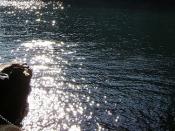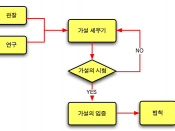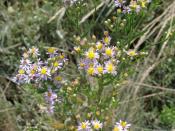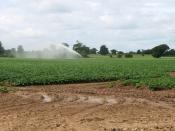Irrigating Crops with Seawater Brown J. Jed, Glenn Edward P., and O'Leary James W. 1998. Irrigating Crops with Seawater. Scientific American.
"Irrigating Crops with Seawater" talks about the global problem of finding enough water and land for the world's population to survive. An estimated 494.2 million acres of cropland is needed just to feed the tropics and subtropics for the next 30 years. However, only close to 200 million acres are available. Therefore, new sources of water and land are needed to grow crops. The writers of this article have been testing the prospect of using seawater in agriculture. This seawater agriculture is when salt-tolerant crops are grown using ocean water for irrigation. Desert areas take up 43% of the surface of the earth and this new agriculture technique can be done in deserts. Hugo Boyko and Elisabeth Boyko first used seawater agriculture after World War II. Many different crops have been tested such as barley and the date palm.
The writers of this article however have been testing halophytes, which, is a salt-tolerant plant that can be used for food, forage and oilseed crops. They first gathered several hundred halophytes and began testing these plants in the desert of Puerto Peñasco. They irrigated the plants daily by flooding the fields with seawater from the Gulf of California. The best halophytes produced roughly the yield of alfalfa using freshwater irrigation. In order to show that these halophytes could replace other crops for use they tested to see if the crops could feed livestock. The halophytes have protein and carbohydrates but they contain too much salt. This limits the amount an animal can eat and dilutes the nutritional value. Therefore, the authors decided to use the halophytes as part of a mixed diet for the livestock. The animals' meat taste was not affected, but the animals eating the halophyte-mixed diet drank more water and produced 10 percent less meat.
This new agriculture method has many advantages too. First, it is cheaper to pump the seawater than to pump freshwater. In addition, seawater irrigation does not require any special equipment. The same fields have been irrigated for 10 years with no water buildup or salts in the root zone. Finally, installing the seawater irrigation will not disrupt the ecosystems as much because they are installed on barren or almost barren areas. There are also some disadvantages to irrigating crops with seawater. First, a large quantity of high-salt drainage water that will contain unused fertilizer will be discharged back into the sea. In addition, the seawater agriculture method will not produce as much crops. More water will also be wasted giving the animals water to drink because of the saltiness.
After reading over the article I believe that this method will prove to be very effective because it will be cheaper and will use water and land that we already have a lot of. I never thought of using seawater for irrigation before and this article told me a lot about it. I believe this article is very relevant to me because I hope to be around for the next 60 years and I will need those plants to provide the food necessary for myself, my children and grandchildren to survive. This new agricultural method will be used for food and will be more economical in the end. This new method is more efficient and effective which will also be beneficial to all. In a modern world like we live in the saying goes, "time is money." The author's have a very similar point of view as I have. I believe that this new agricultural procedure will help many people. This method has always been around, but now it is being tested more vigorously and being put to use more often. Someday it might be a very important farming technique. The authors used the scientific method very well. They first observed that water and land are in shortage. Then they thought of a problem and made a hypothesis as to how they could fix this problem. Then using a control and an experimental variable they tested their seawater irrigation method and compared it to freshwater methods. Then, they recorded their findings and drew conclusions about their work. They noted the positive outcomes and the negative outcomes. I believe that the authors' choices are very reasonable and logical. Their method is well thought out and solves some of the problem of limited water supply, and reduced land availability. This paper leaves many doors open for more research on seawater agriculture. For many years to come, scientists will be trying to devise less expensive and more effective ways of using ocean water for irrigation.
The article "Irrigating Crops with Seawater" is very useful for farmers, scientists and regular citizens. By using this new method, money will be saved, and land and water will be used more effectively. The authors used good scientific skills and intelligent thinking. Seawater is more plentiful than freshwater and the authors have realized this fact and are making use of the water available to their advantage. Overall this article is very good and allows the reader to more critical thinking about ways to utilize seawater to help maintain our existence.





